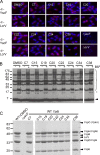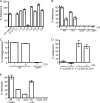Identification and characterization of small-molecule inhibitors of Yop translocation in Yersinia pseudotuberculosis
- PMID: 20498321
- PMCID: PMC2916352
- DOI: 10.1128/AAC.00364-10
Identification and characterization of small-molecule inhibitors of Yop translocation in Yersinia pseudotuberculosis
Abstract
Type three secretion systems (TTSSs) are virulence factors found in many pathogenic Gram-negative species, including the family of pathogenic Yersinia spp. Yersinia pseudotuberculosis requires the translocation of a group of effector molecules, called Yops, to subvert the innate immune response and establish infection. Polarized transfer of Yops from bacteria to immune cells depends on several factors, including the presence of a functional TTSS, the successful attachment of Yersinia to the target cell, and translocon insertion into the target cell membrane. Here we employed a high-throughput screen to identify small molecules that block translocation of Yops into mammalian cells. We identified 6 compounds that inhibited translocation of effectors without affecting synthesis of TTSS components and secreted effectors, assembly of the TTSS, or secretion of effectors. One compound, C20, reduced adherence of Y. pseudotuberculosis to target cells. Additionally, the compounds caused leakage of Yops into the supernatant during infection and thus reduced polarized translocation. Furthermore, several molecules, namely, C20, C22, C24, C34, and C38, also inhibited ExoS-mediated cell rounding, suggesting that the compounds target factors that are conserved between Pseudomonas aeruginosa and Y. pseudotuberculosis. In summary, we have identified 6 compounds that specifically inhibit translocation of Yops into mammalian cells but not Yop synthesis or secretion.
Figures








References
-
- Aiello, A. E., G. F. Murray, V. Perez, R. M. Coulborn, B. M. Davis, M. Uddin, D. K. Shay, S. H. Waterman, and A. S. Monto. 2010. Mask use, hand hygiene, and seasonal influenza-like illness among young adults: a randomized intervention trial. J. Infect. Dis. 201:491-498. - PubMed
-
- Aili, M., E. L. Isaksson, S. E. Carlsson, H. Wolf-Watz, R. Rosqvist, and M. S. Francis. 2008. Regulation of Yersinia Yop-effector delivery by translocated YopE. Int. J. Med. Microbiol. 298:183-192. - PubMed
-
- Bailey, L., A. Gylfe, C. Sundin, S. Muschiol, M. Elofsson, P. Nordstrom, B. Henriques-Normark, R. Lugert, A. Waldenstrom, H. Wolf-Watz, and S. Bergstrom. 2007. Small molecule inhibitors of type III secretion in Yersinia block the Chlamydia pneumoniae infection cycle. FEBS Lett. 581:587-595. - PubMed
Publication types
MeSH terms
Substances
Grants and funding
LinkOut - more resources
Full Text Sources
Other Literature Sources
Miscellaneous

